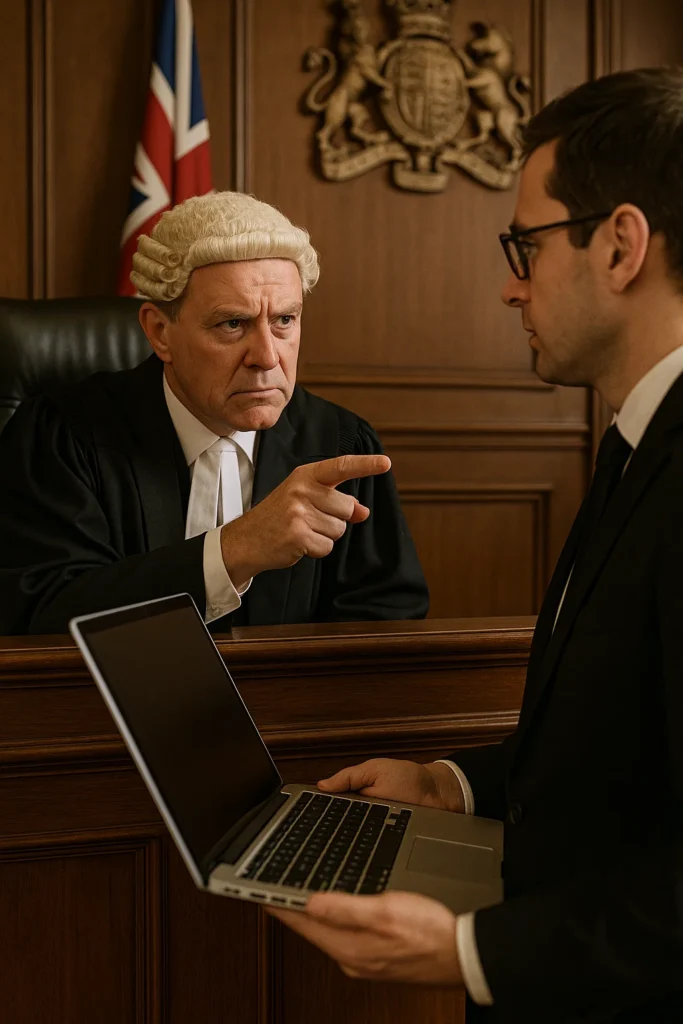On June 6, 2025, judges in the United Kingdom issued a stern and sweeping warning to lawyers across the country: Stop submitting fake legal citations generated by AI tools—or face serious sanctions. This comes in the wake of multiple recent incidents where barristers and solicitors have unknowingly or carelessly included fabricated cases in their legal filings, produced by AI-powered tools like ChatGPT and other generative language models.
The issue isn’t new. But its frequency, coupled with the high-stakes context of legal proceedings, has turned it into a growing concern for judicial authorities. The UK High Court’s latest intervention isn’t just a procedural correction—it’s a pivotal moment in the global conversation about the responsible use of artificial intelligence in legal practice.
UK Judges Draw a Line: Legal Citations Must Be Human-Verified, Not AI-Fabricated
Lord Justice Birss, a senior judge of the Court of Appeal and deputy head of civil justice in England and Wales, made the situation crystal clear: while AI has its utility, its misuse is already endangering the integrity of legal proceedings. Birss underscored that lawyers must personally verify the accuracy and existence of every case they cite, irrespective of how “convincing” the AI-generated reference may appear.
“Submitting fictional authorities is a breach of professional duty,” Birss noted, adding that ignorance about the AI’s limitations is no longer a valid excuse. The judiciary is now urging all legal professionals to treat AI tools with the same caution they would apply to unverified sources on the internet—or risk sanctions including reprimands, fines, and possible referral to regulatory bodies.
When AI Becomes a Liability: The Danger of “Hallucinated” Legal Precedents
At the heart of this issue is a phenomenon now widely known as “AI hallucination”—where large language models generate content that is grammatically plausible, contextually relevant, but entirely fabricated. For the average user, this might mean a bogus Shakespeare quote or a made-up scientific fact. In a courtroom, however, it could mean the wrongful direction of a case or even a miscarriage of justice.
Legal AI tools, often designed to summarize, draft, or suggest precedents, can mimic the language and formatting of genuine case law so well that even seasoned lawyers are occasionally duped. The problem? These tools don’t actually “know” anything—they predict text based on patterns, not facts or verifiable databases.
This raises troubling questions: Should lawyers rely on these tools at all for legal citations? Where does responsibility lie—in the hands of the developer, or the user?
The UK Is Not Alone: World Ripples of AI Misuse in Law
What makes the UK High Court’s warning particularly noteworthy is its timing. In recent months, similar incidents have been reported in the United States, India, and parts of Europe. One infamous case last year involved a New York attorney who cited several non-existent cases generated by ChatGPT—resulting in public backlash and professional embarrassment.
India’s judiciary, too, is grappling with how to integrate AI into its notoriously overburdened system while avoiding the pitfalls of overreliance. With the rollout of digitized filing systems, there’s been a quiet but growing use of AI summarization tools and draft generators—tools that, if left unchecked, could lead to similar ethical breaches.
Ethical Advocacy in the Age of AI
As a researcher working on the responsible adoption of AI in law, this incident in the UK reaffirms a growing thesis: technology is only as ethical as the people and systems that deploy it.
The legal profession—unlike many other fields—is built on precedent, trust, and rigorous documentation. Introducing tools that can hallucinate, mislead, or fabricate erodes these foundational principles. This is not a call to abandon AI; rather, it’s a call to rethink its governance, improve transparency, and build better AI literacy among legal practitioners.
AI’s power lies in its efficiency, but it is not a replacement for human judgment. Lawyers need to view these tools as assistants, not advisors. The distinction is critical.
So, What Needs to Happen Now?
- Mandatory AI Literacy Training: Law schools and bar associations must introduce structured courses on AI tools, their limitations, and ethical use cases.
- AI Use Disclosures in Filings: Courts could require that any AI-assisted work be disclosed in legal documents, similar to conflict-of-interest declarations.
- Stronger Penalties for AI Misuse: Sanctions must not only be punitive but also educational—such as mandatory retraining or suspension from practice.
- Ethical AI Product Design: Tech companies creating legal AI tools need to embed disclaimers, verification prompts, and red-flag systems when generating citations or legal content.
- Cross-Jurisdictional Dialogue: Given the global nature of AI, legal systems across countries must collaborate on setting standards for AI use in legal procedures.
A Crossroads of Law and Technology
The UK court’s warning is more than a local disciplinary moment—it is a wake-up call for the global legal community. As AI becomes increasingly embedded in legal research, writing, and decision-making, we must ask the hard questions now. What role do we want AI to play in the justice system? And how do we ensure that it enhances, rather than undermines, the pursuit of truth?
The rule of law depends on verifiability, responsibility, and integrity. If we allow unverified, AI-generated hallucinations to infiltrate our courtrooms, we risk replacing the pursuit of justice with the illusion of it.
As we stand on the brink of widespread AI adoption in courts, the message is clear: Use AI responsibly—or risk being overruled by your own tools.
For more insights and updates on the ethical use of AI in the legal sector, follow [JustAI] and join our Responsible Law + Tech mailing list.
References:
https://www.nytimes.com/2025/06/06/world/europe/england-high-court-ai.html

